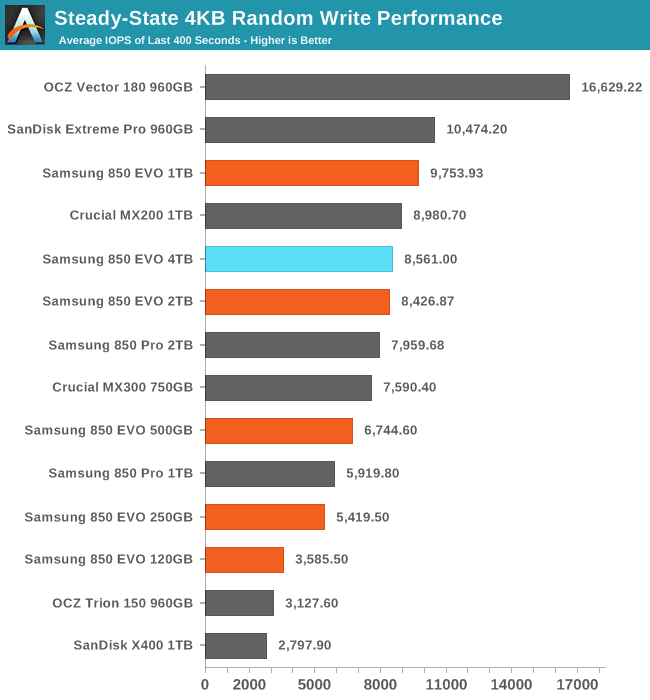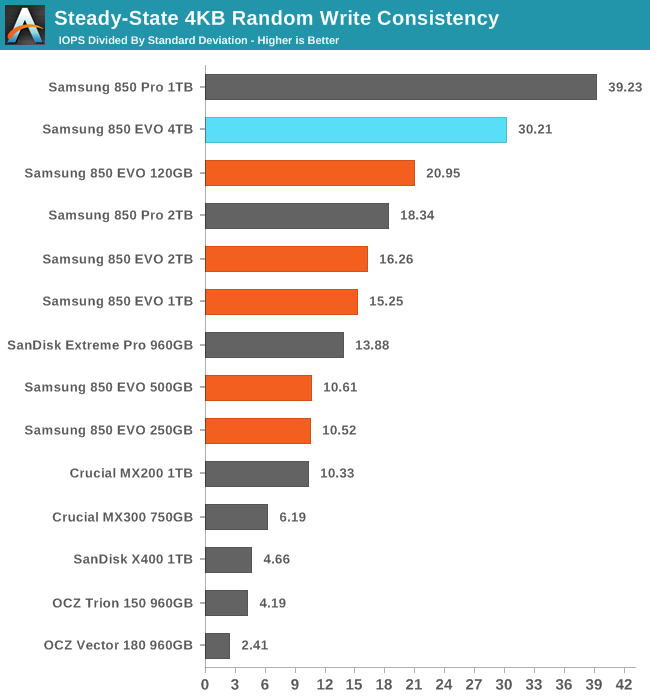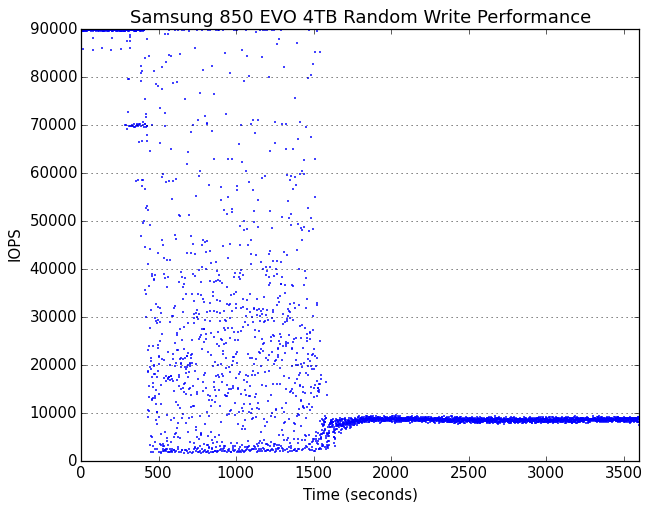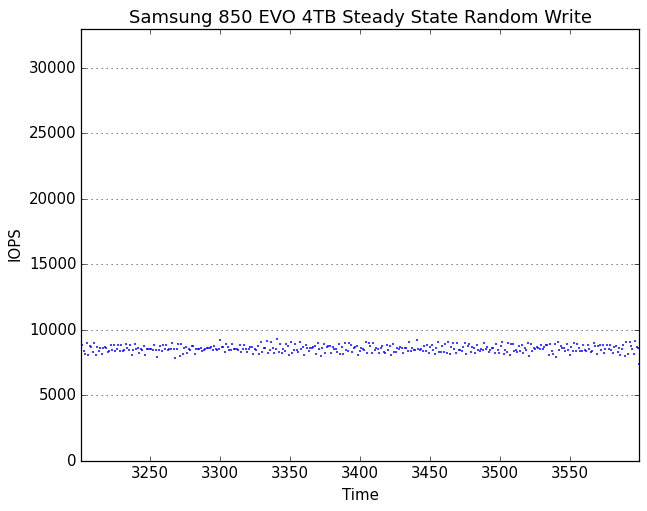The Samsung 850 EVO 4TB SSD Review
by Billy Tallis on July 11, 2016 10:00 AM ESTPerformance Consistency
Our performance consistency test explores the extent to which a drive can reliably sustain performance during a long-duration random write test. Specifications for consumer drives typically list peak performance numbers only attainable in ideal conditions. The performance in a worst-case scenario can be drastically different as over the course of a long test drives can run out of spare area, have to start performing garbage collection, and sometimes even reach power or thermal limits.
In addition to an overall decline in performance, a long test can show patterns in how performance varies on shorter timescales. Some drives will exhibit very little variance in performance from second to second, while others will show massive drops in performance during each garbage collection cycle but otherwise maintain good performance, and others show constantly wide variance. If a drive periodically slows to hard drive levels of performance, it may feel slow to use even if its overall average performance is very high.
To maximally stress the drive's controller and force it to perform garbage collection and wear leveling, this test conducts 4kB random writes with a queue depth of 32. The drive is filled before the start of the test, and the test duration is one hour. Any spare area will be exhausted early in the test and by the end of the hour even the largest drives with the most overprovisioning will have reached a steady state. We use the last 400 seconds of the test to score the drive both on steady-state average writes per second and on its performance divided by the standard deviation.

The 4TB 850 EVO restores a little bit of the performance that the 2TB lost relative to the 1TB, but Samsung's controller architecture is still clearly most comfortable at 1TB.

The consistency of the 2TB 850 EVO was only slightly better than the 1TB EVO, so it's surprising to see the 4TB model make such a large jump and come so close to the 1TB 850 Pro.
 |
|||||||||
| Default | |||||||||
| 25% Over-Provisioning | |||||||||
It is no surprise that a 4TB drive lasts so long before dropping out of peak performance: it has far more spare area to burn through than any ordinary consumer SATA SSD. The transition to steady state is uncharacteristically long and messy for a Samsung drive, and the performance lows during this period are disappointing. Once the drive has reached steady state, there's nothing to complain about.
 |
|||||||||
| Default | |||||||||
| 25% Over-Provisioning | |||||||||
There are no wild outliers from the 4TB 850 EVO's steady-state, and none of the longer-term drift in performance shown by the 1TB and 2TB 850 EVO and Pro models. With extra overprovisioning, the 4TB EVO carries on indefinitely with high and extremely steady performance.










145 Comments
View All Comments
mapesdhs - Wednesday, July 13, 2016 - link
As long as they're able to sell the drives ok at current prices, it won't change. Indeed, if there's a demand spike then prices can rise, for all vendors (others catch on pretty quick if it's obvious consumers are willing to pay more than they'd estimated).This happened a few years ago when 256GB SSDs were just beginning to approach the 100 UKP mark for the first time. One particular store started offering Samsung 830 models for a good price (something like 120 each, I forget offhand), they sold *hundreds* of them in just a couple of weeks. No doubt Samsung realised there was simply no need to reduce the current pricing and infact it went back up very soon afterwards, as did other vendors' prices aswell, returning to 140 to 150 UKP levels by the following Spring.
mapesdhs - Wednesday, July 13, 2016 - link
Just checked, the 830 256GB offer price in late 2012 was 130 each (from ebuyer IIRC); I bought two. I think they sold well over a thousand units.jameskatt - Monday, July 11, 2016 - link
Why would I want to spend $1600 on a 4 TB SSD that only lasts 75 full drive rewrites? That limited drive life makes this an expensive disposable drive. The Samsung 850 Pro has a 10 year warranty. This 4TB 850 EVO won't even last a few years with its limited lifespan. It is useless for video work. You may end up losing valuable video if this dies suddenly.Notmyusualid - Tuesday, July 12, 2016 - link
Yes, this was my first thought too.I went back and checked the Anandtech article for the 850 Pro (rocking 512GB here), and it says 150TB of Endurance, whereas this has 300TB of endurance. Hmmm, the TLC thing still feels wrong to me. Both my 840 Evos performed SO horribly I got rid, and the 850 Pro just so different. And so,my SSD failures to date:
1 x OCZ Indillux shite thing. I'm sure you all remember that drive.
1 x Intel 160GB G1 (doa), replacement strong to this day.
1 x Kingston 60GB whatever
1 x Kingston 120GB whatever
2 x Patriot Wildfire 240GB each (failed ~18 months apart)
I also have an 840 Evo 500GB that I got for 'free', which is giving me no problems, but is used as a 'Steam' disk only, as I in no way trust TLC.
Make a 4TB Pro at $699, and I'll take two of 'em.
Impulses - Wednesday, July 13, 2016 - link
I've been pretty darn lucky... My desktop progression:80GB Intel X25-M
40GB Intel X25-V (for a netbook)
2x 128GB Samsung 830 (ran separately then later RAID)
2x 1TB Samsung 850 EVO + 256GB SM951
0 issues :P
mapesdhs - Wednesday, July 13, 2016 - link
It does vary hugely. I have lots of SSDs I use for benching & system testing, including several dozen OCZ (maybe 50 SSDs total). Only had two problems so far, a SanDisk that went weird during a fw update (which thankfully recovered after a full power disconnect) and a Samsung 840 250GB that went fubar last week for grud knows what reason (stops any system to which it's connected from booting properly). Ironic that I've had a Samsung fail before any of the OCZs I use.It probably helps that the first thing I do when receiving an SSD is make sure the fw is up to date, which in the case of my numerous Vertex2E/3s means they won't be affected by any earlier problematic bugs. Indeed, I've had several V2Es running in UNIX systems for years at a time with no problems (V2E is ideal for this as it was optimised for OSs that don't support TRIM, ie. back when XP was still common).
Notmyusualid - Tuesday, July 19, 2016 - link
I could also have added 1x Intel X25-E 64GB still going strong to this day too.Notmyusualid - Tuesday, July 19, 2016 - link
Sorry, I left out, make 'em at 4TB @ 699, and I'll not only take two of 'em, I'll RAID1 them! Given they are TLC...vladimirovich - Tuesday, July 12, 2016 - link
$1500 for this TLC shit, enjoy!! :)azrael- - Tuesday, July 12, 2016 - link
Isn't there an error in the specification chart? As far as I know only the lower capacity drives up to 500 GB use the MGX controller. The 1 TB drive uses the MEX controller. Unless something has changed...